The Chronological Debate From Adam to Abraham: In Defense of the Masoretic Text
How much time elapsed from the first man, Adam, to the Flood, and then on into the age of the patriarchs? It’s a biblical question that seems fairly straightforward based on the chronogenealogies contained within Genesis 5 and 11: 1,656 years from Adam to the Flood, and 292 years from the Flood to Abraham (or 352 years; there’s some ambiguity about the age of Terah when he begat Abraham).
Yet there is a significant amount of debate about these antediluvian- and patriarchal-period numbers, resulting in wildly different counts—to the tune of nearly 1,500 years.
In our series on biblical chronology, tracing from the early biblical monarchical period back through the time of the judges, the Exodus, the sojourn and patriarchal period, we’ve looked at the various debates as they surround internal biblical numbers and archaeological remains, filtering the collective evidence in order to ascertain the correct periods of time for events described in the Bible and in turn witnessed on the ground.
For this final article, however, the picture is somewhat different. Archaeological material to one side, a significant debate among Bible literalists for the period between Adam and the patriarchs lies singularly with the internal biblical evidence, with entirely different numbers provided across this “prehistoric” and early historic period by different scriptural traditions: the Masoretic Text, the Septuagint and the Samaritan Pentateuch.
How much time really spanned from Adam to Abraham?
MT, LXX, SP
The Masoretic Text (mt) of the Hebrew Bible, or Old Testament, is widely given precedence as the most authentic preservation of the Hebrew Scriptures, based on its incredibly careful transmission by Jewish scribes—as particularly demonstrated by the copying work of the first-millennium c.e. “Masoretes,” whom it is named after (read “Can You Trust the Masoretic Text?”).
Though the earliest complete Masoretic Bible dates to the 11th century c.e. (the Leningrad Codex), it is found in partial forms and fragments throughout the prior millennium (and even earlier).
The mt is held by Jews and many Christians alike as the authoritative, authentic text of the original Hebrew Bible, held by tradition to have been preserved in a continuous methodological copying practice instituted by the fifth-century b.c.e. scribe Ezra. Because of its historically careful and pedantic copying tradition—dot for dot, letter stroke for letter stroke, cross-checking and numbering absolutely everything—this is the textual form typically relied upon by most translations of the Hebrew Bible/Old Testament.
If you use a King James Bible, for example, its Old Testament is a translation of the Masoretic Hebrew text. And, of course, the mt constitutes the only recognized, authentic Hebrew Scripture used in Judaism. But it’s not the only textual variant.
The Septuagint (lxx) is an early Greek translation of the Hebrew Bible. Initially, it was a translation solely of the Torah (Pentateuch, or first five books of the Bible), which was completed by a select number of scribes working in Egypt during the third century b.c.e. at the behest of ruler Ptolemy ii Philadelphus (as attested by classical writers, such as Josephus and Philo. The abbreviation lxx represents the Roman numerals for “70,” based on a tradition that it was the work of 70—or, 72—translators). Sometime probably during the second century b.c.e., the remainder of the Hebrew Bible was translated into Greek, making up the rest of the Septuagint scripture.
The lxx however, unlike the mt, is not a highly standardized text: The books are not ordered in the same tripartite division (Law, Prophets, Writings), and the lxx also includes various apocryphal works. Further, several books—such as Job and Jeremiah—are significantly shorter, while other books—such as Esther and Daniel—contain significant additions. Given these stark differences, the Septuagint is often seen as a spurious and inferior text. Still, certain Greek-centric Christian groups (for example, the Eastern Orthodox) do traditionally prefer to use the Septuagint Old Testament.
Despite some of the more major, later differences in the rest of the lxx scripture, the lxx Torah/Pentateuch is, taken in its entirety, a generally close translational match for the Hebrew mt Torah. However, among these first five books of the Bible, there are certain select differences. Intriguingly, chief among them are the lxx chronologies in Genesis 5 and 11. These passages contain notably different numbers, to the tune of roughly 600 additional years for the antediluvian world and 800 additional years following. Further, the Septuagint genealogy adds an extra individual for the post-Flood-period genealogy up to Abraham—an individual named Cainan.
But the mt and lxx are not the only different scriptural traditions. There’s also the Samaritan Pentateuch (sp). This is the Torah belonging to the Samaritan community. Again, the earliest full-preserved copy of this text dates quite late, to the 13th century c.e. However, it is generally believed to have originated in this form long prior, perhaps around 100 b.c.e. With a written form very similar to Hebrew (in the slightly variant Samaritan script), it is again a generally close match to the standard Jewish Masoretic version—however, there are a few key differences.
Famously, the Samaritan “10 Commandments” include a mandate for the community’s iconic worship at Mount Gerizim. And there are also notable peculiar differences relating to the chronologies of Genesis 5 and 11. The sp more or less holds to the mt’s chronology pre-Flood but contains more similarities with the lxx’s longer chronology post-Flood.
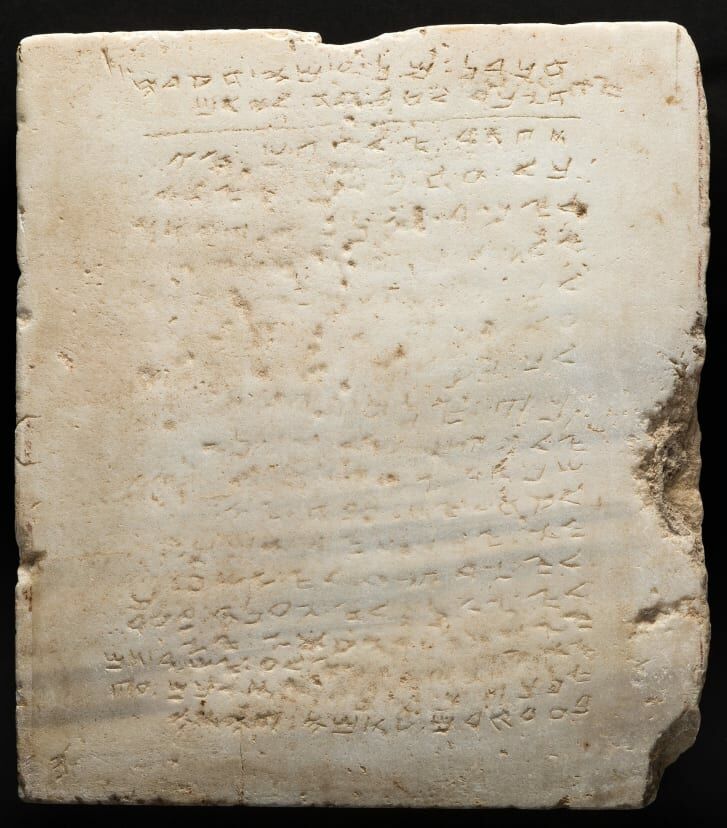
Debate about these textual differences has gone on for (at least) the past 1,700 years, with different theologians and historians arguing for the primacy of one over the other. Naturally, the Hebrew mt is widely given favor overall as the most authentic, best-preserved account—yet even in this debate, many of those who argue for overall primacy of the mt also argue that, in the case of the Genesis 5 and 11 chronologies, one of the other scriptural traditions should be followed as original instead (primarily the longer lxx, often in an attempt to harmonize with an elongated secular timeline of history).
Again, when it comes to chronology, this is no small debate of a decade or two—this debate potentially carries chronological differences of well over a thousand years. And it calls into question more widely the overall veracity and standard to which the mt is held, as the honest, authentic preserve of the Hebrew scriptures.
Why these strange chronological differences in each of the primary textual variants for this early period of time? Which is the best, most accurate, original transmission of this text? And given the nearly 2,000 years of debate, can we come to a satisfactory conclusion? In the following study we examine these questions—and make the case for the numbers contained within the Masoretic Text of Genesis 5 and 11 as indeed authentic and original.
The Numbers at a Glance
Let’s start with a comparison of the numbers. Below is a side-by-side comparison of the chronogenealogies found in Genesis 5 and 11, from left to right, in the mt (green), lxx (yellow) and sp (red). In the left-hand column of each table, there is the age of each individual (from Adam to Abraham’s father, Terah) at the time each one “begat” his son; middle is the remaining period of each one’s life; to the right is his total lifespan. The final right-hand column of each table is the individual’s percentage of his overall lifespan at which he begot the next generation.

From these tables, we can make some interesting immediate observations. Again, most obviously, the lxx chronology contains an extra individual (Cainan) that the mt and sp do not (compare the lxx Genesis 11:13 with verse 12 in most other translations). Another key observation is that while the overall lifespans across all individuals are generally the same, for the lxx, most ages of begettal are exactly 100 years older than those of the mt. For example, while both have Adam living to the ripe old age of 930, the Hebrew mt has him begetting Seth at 130, while the Greek lxx has this age of begettal at 230—thus adding to the antediluvian chronology an extra 100 years. It’s a similar story for much of the list: Seth, mt begettal at 105 versus lxx at 205; Enos: mt 90, lxx 190. This largely continues through the post-Flood genealogy up until Abraham’s grandfather Nahor, who in the lxx chronology is exactly 50 years older than the mt’s (79 versus 29). Things are a bit more convoluted with the Samaritan Pentateuch: Again, these sp numbers generally follow the lower mt numbers pre-Flood, but then flip to something more akin to the longer lxx numbers post-Flood.
Looking at such a spread of text across three different tables (as is typically presented in this debate) can be difficult to properly compare and conceptualize. As such, below are the numbers again, this time in graph form, from left to right—mt, lxx, sp respectively. The red line represents total lifespan; the green, age at begettal for the next generation.

Here things become even more obvious and interesting. We can see (and dismiss) a couple of outliers for our purposes here—namely Enoch (the dramatic red-line “v” dip), who, at a “young” age, “God took him” (Genesis 5:24); also Noah, who begot Shem at an extremely advanced age (the dramatic green-line inverted “v”). In this format, we can see some general trends. Of course, in all cases, we have the famous extremely long pre-Flood lifespans, with the ages sharply dropping off following the Flood.
In the case of the Samaritan Pentateuch, though, we see something very unusual. Because the initial pre-Flood chronology matches the shorter mt, and the post-Flood chronology matches the longer lxx, we have a truly peculiar situation: While overall lifespans collapse post-Flood, we actually see age of begettal doubling—to the point where the final five individuals are all successively begetting the next generation well into the latter half of their lives.
In this respect, as represented graphically, the sp chronology just doesn’t make sense: a shorter timeline for births pre-Flood, against a backdrop of much longer lifespans, then a longer birth time frame after, yet much shorter lifespans?
Based on this (and other) signs of unlikely artificial manufacture, the sp’s chronology isn’t usually defended in this debate as representative of the original, authentic overall chronology. Typically, the battle is between proponents of the shorter mt and the much longer lxx. (One particular proponent defends the sp in an article titled “Samaritan Chronology of Antediluvian Patriarchs in Genesis 5 and Prime Numbers.” He argues that all the chronologies are non-literal, “carefully constructed artificial systems of chronology” anyway: This certainly will be a non-starter for many Bible literalists.)
But what about the hotly debated mt and lxx?
The Problem With Cainan
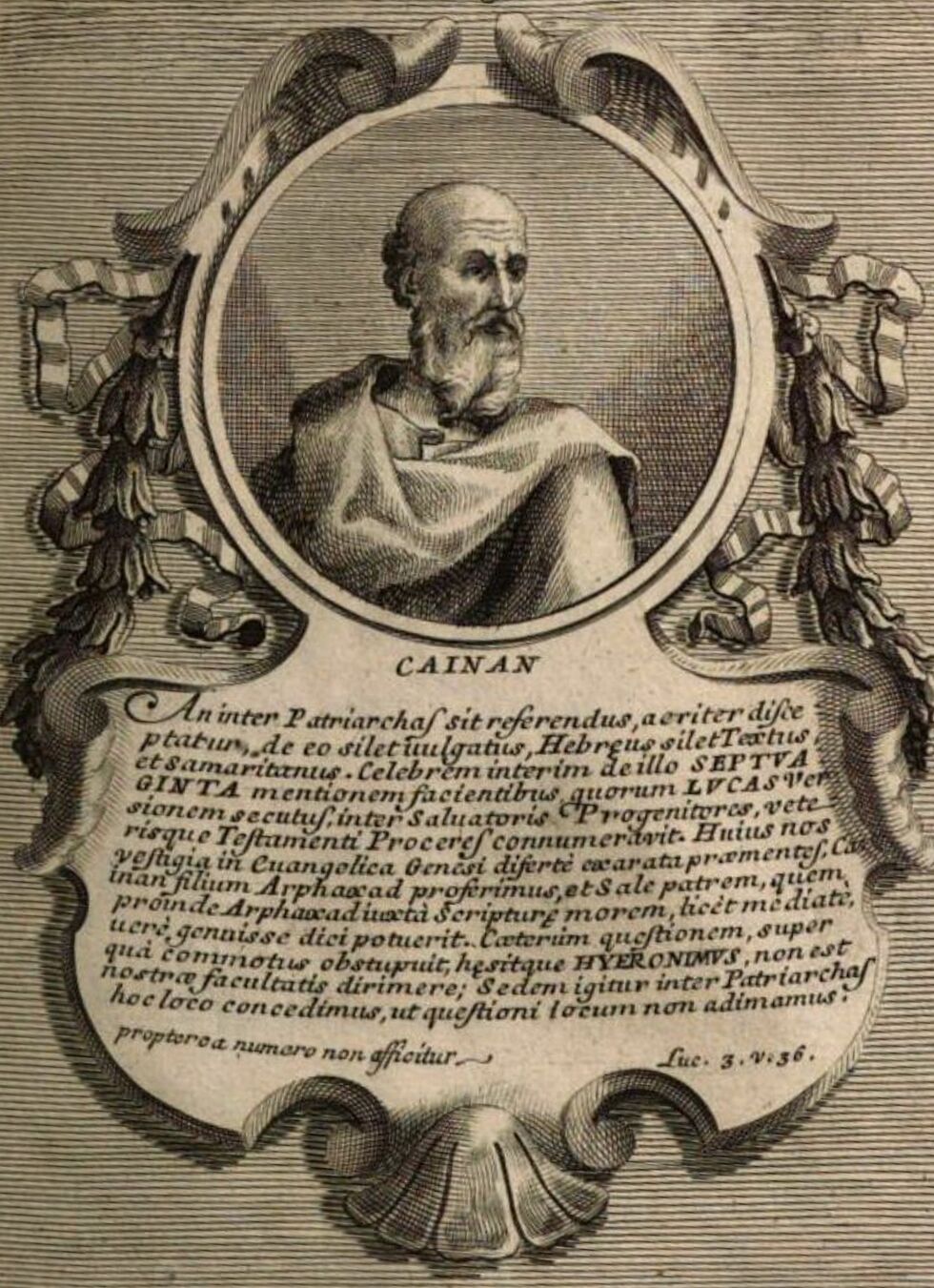
The question of Cainan’s existence is one key reason for the debate about the authenticity of the lxx chronology over that of the mt, particularly among Christians. That’s because Cainan is found in the New Testament, in Luke’s genealogy of Jesus (Luke 3:36). As such, this passage is held by some to be a New Testament endorsement of what must have been a correct lxx chronology, including this individual.
There’s just one issue that has long been highlighted with regard to this verse: A fragment known as Papyrus 75, showing this passage of Luke in question, contains no evidence of the name Cainan. This papyrus fragment potentially dates as early as the second century c.e. In such manner, due to the notion that the name “Cainan” was a later addition, some translations of this verse exclude “which was the son of Cainan,” such as the Bishop’s Bible of 1568 (one of the earliest English translations). The McClintock and Strong Biblical Cyclopedia notes: “It is believed by many, however, that the name of this … Cainan was not originally in the text even of Luke, but is an addition of inadvertent transcribers, who, remarking it in scmi copies of the Septuagint [of Genesis 11], added it (Kuinol, ad Luc. 3:36).”
The assertion about Papyrus 75 has become a hotly debated topic for reexamination in recent years, with certain lxx proponents claiming that the fragment in question isn’t preserved enough to tell whether or not it did originally contain the name. This position is not held among all lxx proponents, however. Some maintain that the New Testament name was indeed a later scribal addition but based on an even later, “corrupted” version of the Septuagint, composed in the third century c.e., in which Cainan is theorized to have been added to Genesis 11 and subsequently also Luke 3 (see, for example, Dr. Jonathan Sarfati’s article “How Do You Explain the Difference Between Luke 3:36 and Gen. 11:12?”).
But we’re getting bogged down into weeds. Let’s step back a little, and look at the broader picture. We have no Cainan in the Masoretic genealogy. We have no Cainan in the Samaritan genealogy, nor in other early translations of Genesis 11—the Chaldee, Syriac or Vulgate. We have no Cainan in the first-century historian Josephus’s genealogy (see Antiquities, 1.6.4-5). He is likewise missing from the first-century Philo’s accounts. And perhaps most condeming of all: 1 Chronicles 1 actually duplicates the genealogies of Genesis 11—and in this passage, the Septuagint text itself likewise omits Cainan! (1 Chronicles 1:24.)
“It certainly was not contained in any copies of the Bible which Berosus, Eupolemus, Polyhistor, Theophilus of Antioch, Julius Africanus or even Jerome, had access to,” McClintock and Strong’s continues. “Moreover, it seems that the intrusion of the name even into the [Septuagint] is comparatively modern, since Augustine [fourth–fifth centuries c.e.] is the first writer who mentions it as found in the [Old Testament] at all.”
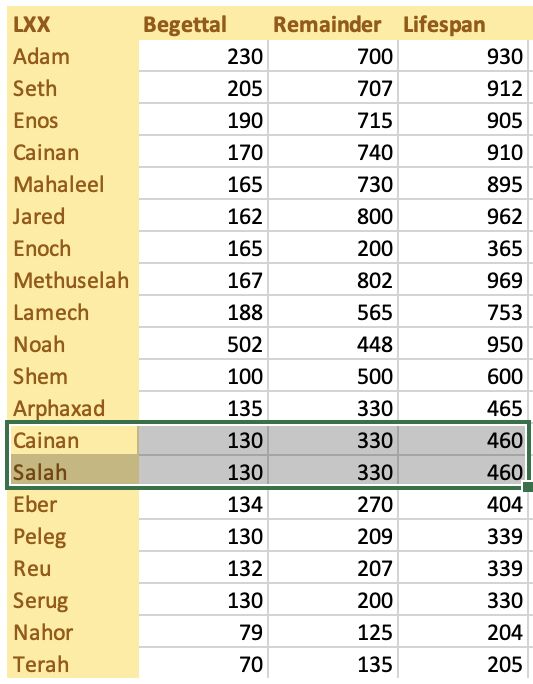
We can further examine this question from another angle. On our lxx table (see left), there is something very peculiar: Both Cainan and Salah, the individual who follows him, are exactly the same age when they beget a son (130), and live exactly the same number of years afterward (330), reaching exactly the same age in life (460; see Genesis 11:13-15 in the lxx).
What are the chances? Both father and son begetting the following generation at 30 would be one thing. But both at 130, and both dying 330 years later?
No wonder the question about Cainan’s legitimacy—and the predominant theory of an lxx copyist’s error for Genesis 11 (intentional or not), in reinserting an already used earlier name, Cainan (the earlier son of the antediluvian patriarch, Enos), followed by an insertion into Luke’s genealogy to match. (Indeed, is it just coincidental that this debate centers around the only individual in these early genealogies for which we have a duplicate name?)
But Cainan is not the only problematic member in the lxx’s genealogy.
The Problem With Methuselah
The Bible is very clear that the Flood came when Noah was 600 years old (i.e. Genesis 7:11) and that only he, his wife, his three sons and their wives survived—eight individuals (Genesis 7:13, 23). Counting back in time on the lxx chronology, however, we find something remarkable: Methuselah evidently somehow survived the Flood!
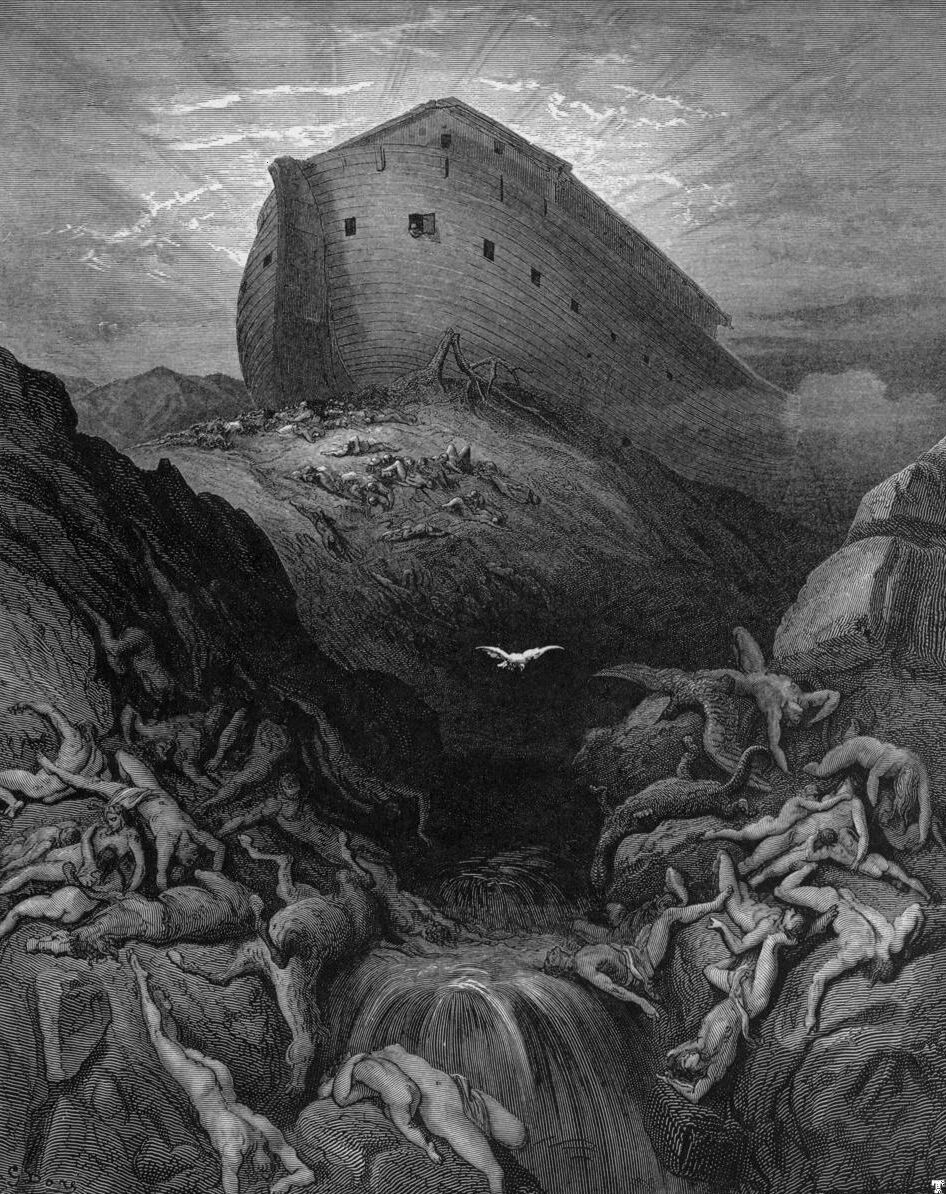
Here are the pertinent scriptures, from the Brenton translation of the Greek lxx: “And Mathusala lived an hundred and sixty and seven years, and begot Lamech. … And Lamech lived an hundred and eighty and eight years, and begot a son. And he called his name Noe …. In the six hundredth year of the life of Noe … the flood-gates of heaven were opened” (Genesis 5:25, 28-29; 7:11).
Thus, the number of years from the birth of Methuselah to the Flood: 167 + 188 + 600 = 955 years.
How long, according to the lxx, did Methuselah live? “And all the days of Mathusala which he lived, were nine hundred and sixty and nine years, and he died” (Genesis 5:27). 969 years—Methuselah therefore somehow survived the Flood by a full 14 years!
Of course, such a dramatic error within the lxx chronology has not gone unnoticed. As such, lxx proponents are quick to argue that the mt’s 187 begettal figure for Methuselah must have also been “original to the lxx translation and to Moses” and that “the reading of 167 in certain manuscripts of the lxx is a scribal error which occurred early in its complex transmissional history”; yet, “the appearance of 167 in some lxx manuscripts does not automatically negate the overall validity of the lxx’s primeval chronology” (from the article “Methuselah’s Begetting Age in Genesis 5:25 and the Primeval Chronology of the Septuagint”).
Not a confidence-inspiring endorsement for the lxx over and above the mt. Nonetheless, if we are to follow this line of reasoning, this amendment to 187 would indeed suffice in ensuring the Septuagint’s Methuselah did not outlast the Flood—instead, putting his death six years before.
Compare this, however, with the mt chronology. The Masoretic Text has the same overall lifespan of 969 years for Methuselah. It has Methuselah begetting Lamech at 187, Lamech begetting Noah at 182, and the Flood coming when Noah was 600—therefore making Methuselah 969 at the time of the Flood. Not only does this number fit, in that it doesn’t extend Methuselah’s lifespan past the Flood—its precision to the very same year as the Flood is certainly more than coincidental, indicating either that the Flood was the cause of Methuselah’s death, or that his death signaled the arrival of the Flood.
There’s actually a good reason for Methuselah’s death happening the same year as the Flood: his name. Methuselah (מתושלח), according to Dr. Henry Morris, means “when he dies, judgment”; or, as per Dr. Judson Cornwall and Dr. Stelman Smith’s Exhaustive Dictionary of Bible Names: “When he is dead [מתו], it shall be sent [שלח].”
This leads us to another problematic individual in the lxx timeline.
The Problem With Lamech
The mt’s precise alignment of Methuselah’s death with the year of the Flood has led certain lxx proponents to concede that the lxx age for Lamech’s begettal of Noah—188—should also be regarded as a “scribal error” and amended to match that of the mt (182), in order to line up Methuselah’s death with the same year as the deluge. In “Methuselah’s Begetting Age in Genesis 5:25 and the Primeval Chronology of the Septuagint,” Henry Smith Jr. wrote:
This six–year discrepancy between the mt (182) and lxx (188) is historically and textually complex. Lamech’s numbers in the lxx (188, 565, 753) most likely arose in the original translation from a scribal error while the translator was reading the Hebrew Vorlage [the hypothesized Hebrew original the lxx was based on], followed by a complex, two-stage and deliberate scribal emendation to correct the chronological matrix.

Or put more simply by another lxx proponent in his less-than-subtly titled article, “The Septuagint (LXX) vs. Corrupted Masoretic”: “Lamech’s begetting age for Noah in the lxx reads 188, but this is a scribal error and the correct age Lamech’s son Noah was born is in his 182nd year in the mt ….”
Again, hardly a confidence-inspiring endorsement of a so-called “correct Septuagint” over a “corrupted Masoretic” text—the lxx begettal ages for both Methuselah (167) and Lamech (188) argued by proponents to be simply the result of “scribal error” and emended to match that of the mt. Which, exactly, is the “corrupted” text?
Back to the Graphs
There is more vital information we can glean from our graphs. We have already observed the topsy-turvy, unlikely nature of the sp chronology pre- and post-Flood. Let’s compare, a little more closely, the mt to the lxx.
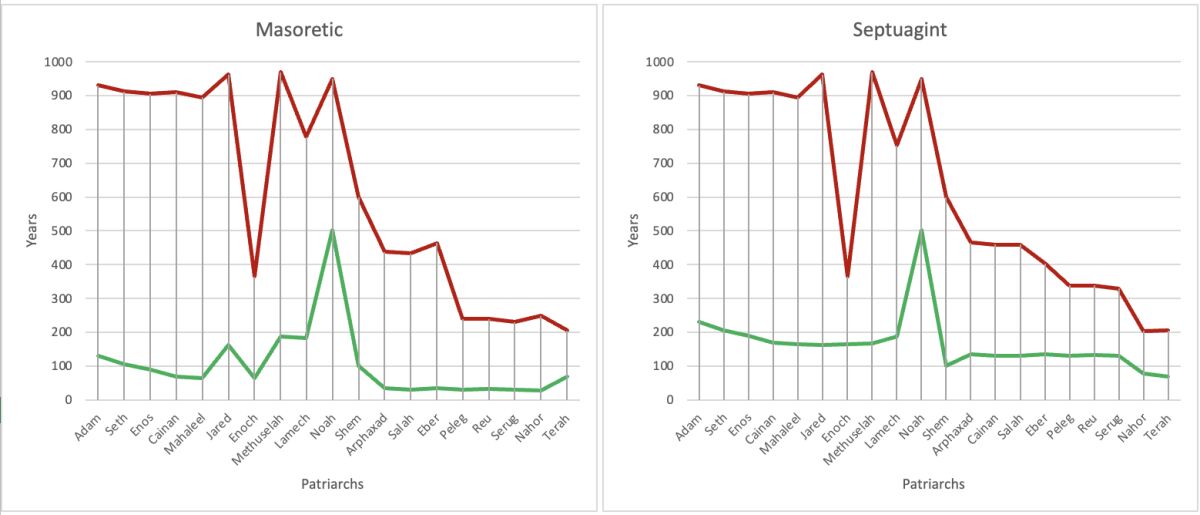
Note the far more linear nature of the ages of begettal (green lines) on the lxx graph (right) as compared with the mt (left). Despite the perhaps immediate attractiveness of this smooth lxx line on both sides of the Flood (Noah excepted, again), it belies an artificial construction. Compare the latter half of the genealogies, for example—those after the Flood. Both mt and lxx are fairly linear. Yet the ages of begettal from the mt are nothing out of the ordinary: 35 years old, 30, 34, 30, 32, 30, 29. Consider the lxx ages, on the other hand: 135, 130, 130, 134, 130, 132, 130.
The lack of believability is decidedly not in the advanced age. After all, Bible literalists are typically not averse to immense biblical ages. The unbelievability—and stamp of artificiality—is in the unlikely uniform proximity of such advanced ages—differing only by five years, yet all within the 130s. For the mt to have three out of six individuals begetting at the age of 30, and five out of six begetting within their 30s—nothing unusual there. But for the lxx to have four out of seven begetting at the age of 130? And for all seven in a row to be within their early-to-mid 130s? The Septuagint’s graph is simply too flat, the numbers too even, for such advanced ages.
Further to this point: lxx proponents naturally argue that the mt ages of begettal have been artificially lowered by exactly 100 years. mt proponents, conversely, argue that the lxx ages of begettal have been artificially inflated 100 years. Antediluvian world aside (for which each chronology’s ages are markedly higher): These mt ages of begettal post-Flood are all entirely “normal,” in the 20s and 30s. What are the chances—if these mt ages really were only arbitrarily reached by evenly and consistently minusing 100 years from the “original” lxx timeframe—that all six individuals in a row just happen to match precisely with standard ages of begettal today and throughout history? Clearly, this logic of “minusing” 100 years is the wrong way around.
What about the unusual lxx age of Shem in begetting a son? Why was the lxx Shem so much younger at the begettal of his son compared to all those on either side of him, both pre-Flood and post-Flood? Especially for a progenitor born before the Flood, when the lxx ages of begettal for pre-Flood individuals are so much higher?

Yet for the Masoretic Text, the age of begettal for Shem is consistent with the begetting ages of other similar individuals born pre-Flood. Overall ages of begettal in the mt only drop off among those born post-Flood, starting from Shem’s son Arphaxad. It makes logical sense for all those born post-Flood to beget at “normal,” younger ages (around the mid-30s)—rather than the lxx’s rebound in age of begettal post-Shem to the mid-100s, and then a drop-off (for whatever unknown reason) at the time of Abraham’s grandfather.
The mt graph suggests the logical conclusion that, along with the post-Flood environment causing overall lifespans to sharply decline, there was a corroborating decline in ages of begettal. The lxx and sp have overall ages similarly declining, but ages of begettal remaining peculiarly and stubbornly linear and unchanged—right through to the time of the biblical patriarchs, when they suddenly drop off.
And that’s another thing: Surely, if the post-Flood lxx and sp chronologies were correct and people immediately prior to Abraham were regularly and typically begetting children in their mid-100s (130, to be precise!), there would have been no concern about Abraham producing an heir in his old age? Yet Abraham wondered in Genesis 17:17, “Shall a child be born unto him that is a hundred years old?” The Bible highlights Abraham’s advanced age in child-begetting as a special blessing for him. (Compare also with Romans 4:19 and Hebrews 11:12.)
Origen’s Origins vs. Josephus Justification
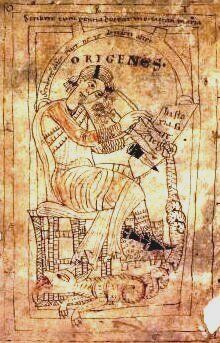
The issues with the lxx chronology go on. Take it from one of the individuals most responsible for the transmission of this text, a third-century c.e. Christian scholar based in Alexandria, Egypt: Origen. In “Design and Development of the Holy Scriptures” (1971), Dr. Ernest Martin wrote: “Origen, who is responsible for giving us the Septuagint version we have today, had several copies of the Septuagint. But each one differed in places from the other. Origen attributed this to the ‘carelessness of the scribes, or rash and mischievous correction of the text by others.’”
Or, take it from Jerome, translator of the Latin Vulgate. As summarized by the Online Bible’s Larry Pierce: “We know that when Jerome (AD c. 347–419/420) translated the Vulgate (Latin translation of the Bible) in the 5th century AD, he did not use the LXX in spite of Augustine’s (354–430) pleadings because Jerome said it was too inaccurate” (article, “Cainan in Luke 3:36—insight from Josephus,” emphasis added throughout).
Put bluntly: The Septuagint, as a whole, is widely regarded as a mess in preserving the overall biblical account—hence the widespread use of the mt as the basis for translations of the Hebrew Old Testament. Some 400 lines are missing from the lxx book of Job, as well as a full 30 percent of the book of Jeremiah. Certainly, the lxx’s Torah translation is more precise compared with the later books in the canon. But there are still several glaring issues (some of which we have covered already). Are we therefore to trust it more than the mt and its renowned copying tradition when it comes to preservation of the numbers of Genesis 5 and 11?

Still, the earlier first century c.e. Jewish historian Josephus is sometimes held up by lxx proponents as evidence for the longer Septuagint chronologies. Yet in many ways, Josephus’s early chronologies are a law unto themselves—not only do they conflict with numbers in both the lxx and mt, they also conflict with each other.
A case in point is the period from the Exodus to the building of the temple (1 Kings 6:1). The lxx gives 440 years. The mt gives 480 years. Josephus far exceeds that in Antiquities of the Jews (8.3.1), giving 592 years—and then exceeds it again in Against Apion (2.2), giving 612 years! Or take the reign of Solomon: Both the lxx and mt ascribe to him 40 years (1 Kings 11:42; 2 Chronicles 9:30). Josephus gives him a reign of 80 years (Antiquities, 8.7.8).
Josephus does agree with the mt and sp in omitting Cainan. Yet for his early Genesis chronological information, there is enormous scope for debate, with allegations from lxx proponents that certain longer ages matching the lxx are original to Josephus and those that appear to more closely match the mt must be the product themselves of later scribal editing. Again, it is all too easy to bog down in the weeds in this subject.
But in our analysis of the evident problems with the lxx and sp, we have not yet looked at a vital angle: the hidden, inherent (and at this point, rather refreshing) perfection of the numbers contained within the doggedly consistent mt.
Don’t Forget the Numerics
In earlier articles on this website, we have mentioned the significance of Bible numerics and the divine symbolism contained within biblical chronologies—not just of a figurative, symbolic nature, but also a very literal one (read our articles here and here). We see a clear and obvious repetition, for example, of the biblically significant numbers 7, 12, 40, 360, 1,260, 2,520, etc.
For example, not only is there the obvious significance contained within the mt’s precise calculation of Methuselah dying the very same year as the Flood, there is also the significance of Methuselah’s son Lamech, father of Noah, dying several years earlier as a foreboding witness at the age of 777 (Genesis 5:31). This is a significant figure present only in the mt.
But there is another, more dramatic numeric angle at play in Genesis 5 and 11. In the mt-versus-lxx debate, the question of whether or not the ages of begettal were artificially inflated by 100 years in the lxx or deflated by 100 years in the mt receives the most focus. But the ages of begettal do not bear all the significance. There is a remarkable, hidden significance to the overall ages too.
If you add all the lifespans contained within the lxx from Adam to Moses, you arrive at a figure of 13,386.
If you add all the lifespans contained within the sp from Adam to Moses, you arrive at a figure of 11,993.
Yet if you add up all the lifespans contained within the mt from Adam to Moses, you arrive at a figure of 12,600.
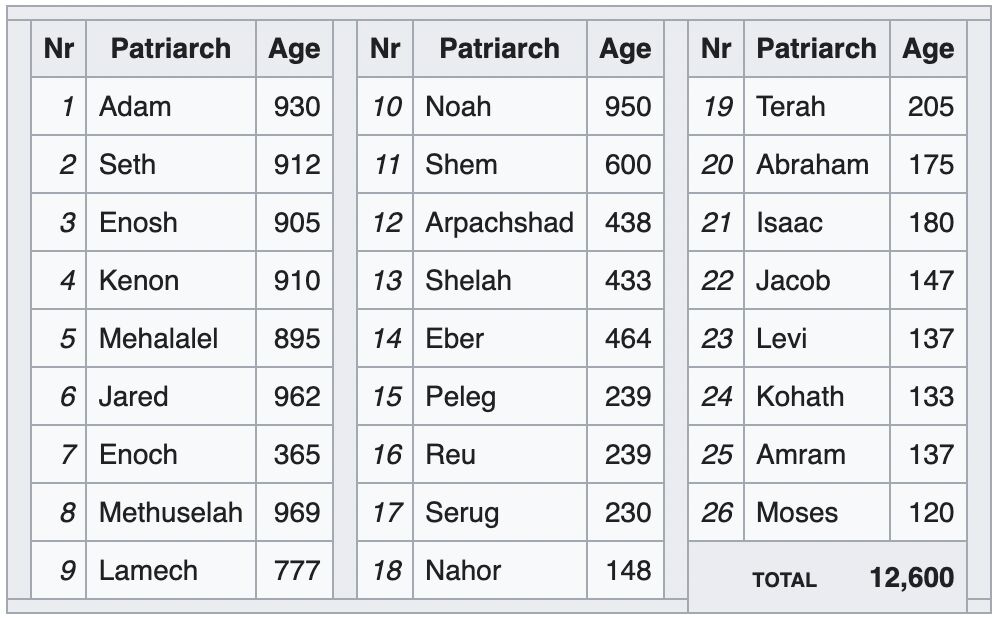
Arriving at such a round figure is notable in itself, given the many non-rounded figures within the genealogy (i.e. 912 years here, 433 years there—see table, right). But this figure of 12,600 is rather more significant. This sum is an even multiple of the biblically significant numbers 7 (7 x 1,800), 12 (12 x 1050) and 40 (40 x 315). It’s also a multiple of each of the prophetically and symbolically significant large numbers found in the Bible: 360 (360 x 35), 600 (600 x 21), 1,260 (1,260 x 10) and 2,520 (2,520 x 5).
Coincidence? Fingerprints of the mathematical genius of a scribe? Or, just perhaps, the fingerprints of divine inspiration in a text that claims to be “God-breathed”?
Such layers of numeric harmony only add to the other evidence highlighting the Masoretic as the original, and the Septuagint and Samaritan Pentateuch as later derivatives and “corruptions.”
Such numerical harmony—777 years for Lamech, Methuselah dying the same year as the Flood, 10 generations to Noah, 10 generations to Abraham, 22 generations from Adam to Israel (a significant number specifically to Israel, entirely missed with the lxx addition of Cainan—22 is also the number of letters in the Hebrew alphabet and the original number of books in the Hebrew Bible), and a total of 12,600 years of lifetime from Adam to Moses—had to be baked into the chronology from the beginning. This is a perfection entirely overlooked and unrealized in later, devolving alternative chronologies.
Which, then, is the original and—dare it be said—superior chronology? The topsy-turvy Samaritan Pentateuch? The repeatedly conflicting and amended Septuagint? Or the consistent and numerically harmonious Masoretic?
Was the Septuagint the Old Testament of the New Testament?
One reason some Christians prefer to hold to the Septuagint text is the belief that it was the version of the Old Testament being used and quoted in the New Testament by Jesus and the apostles.
This, however, is far from the case. This article is not the place for a detailed discussion of this question. Naturally, given the New Testament uses the same Greek language, it shares similarities with certain passages of the Septuagint. Yet there is a far greater number of differences. Let the following summarization by Dr. Martin suffice (“Is Judaism the Law of Moses? Pt. 7,” June 1961):
It has often been assumed that the Septuagint version, instead of the original Hebrew Text, was the Old Testament of the early Christian Church. This is decidedly not the case.
It can be shown quite plainly that Christ did not set the example of using the Septuagint version. It was His custom to quote from the original Hebrew scrolls (Luke 4:16, 17). Also, Christ referred to the three divisions of the Hebrew Bible as the scripture (Luke 24:44, 45)—the Septuagint version did not contain these three divisional designations (International Standard Bible Encyclopedia, Volume 1, page 555). …
Some scholars have endeavored to maintain that the apostles used the Septuagint version as their Old Testament, and that their Old Testament quotations in the New Testament were from the Septuagint. However, we are informed by Collett (The Scripture of Truth, pages 142-143), that of 263 direct quotations from the Old Testament, only 88 are verbal quotations that agree with the Septuagint. Does this prove the apostles used this version? The answer should be obvious—it does not!
As for those places that do match, Dr. Martin posits the following in “Design and Development of the Holy Scriptures”:
Origen, who is responsible for giving us the Septuagint version we have today, had several copies of the Septuagint. But each one differed in places from the other. … How to correct them and have a good version? “By the help of God, using our own criterion the other versions.” In other words, he used [the New Testament], which he highly esteemed. That is why in 88 quotes the Septuagint version agrees with the apostles—not that the apostles agreed with it or quoted it.
Assessing Motive: Why Would Ages Be Changed Anyway?
Clearly, ages have been changed by early scribes. But the question is not just one of which text—mt or lxx—but also necessarily one of why. One of the most common reasons given by Christian lxx proponents for alleging Jewish corruption of their own sacred scriptures (specifically, an alleged deflation of the numbers in Genesis 5 and 11) is that it was an attempt to obscure the identification of Jesus as Messiah.
This is in relation to a common belief in Judaism and Christianity that the Messiah will come by, or just prior to, the year 6000. This is connected to the six days of Creation and days of the workweek, followed by a seventh-day Sabbath of rest—each day symbolizing 1,000 years of world history, with a seventh-day, millennial messianic “Sabbath” (see, for example, Psalm 90:4, 2 Peter 3:8, and Revelation 20:4).
The current traditional Hebrew count, based on a second-century c.e. rabbinic calendar known as Seder Olam Rabbah, has us currently 5,783 years from Creation. Actually, this traditional date is widely recognized as being significantly wrong, even among rabbis and Jewish scholars; this is known as the “Missing Years” debate, centering around a missing post-exilic block of 165 years (during the time of the Persian empire). Accounting for these years, this would put us somewhere in the vicinity of 5,950 years from Creation (or potentially decades later), based on the mt chronologies in the Bible and paired with later conventional chronologies (you can read more about this subject in our article here).
Some lxx proponents, from antiquity to today, have sought to align these dates with the arrival of Jesus on the scene in the first century c.e. The lxx chronologies of Genesis 5 and 11 would put this first-century period not at the year 6000, but at least generally within the “sixth millennium” (5000–6000)—more specifically, depending on how they are counted, somewhere around 5,500 years from Creation to Jesus (thus putting us today somewhere around the 7,500-year mark).
Smith’s “The Case for the Septuagint’s Chronology in Genesis 5 and 11” states: “In some schemes, the Messiah would arrive in the sixth millennium from Creation (5000–5999) …. The Seder Olam was developed and written by the very same rabbis who deflated the mt’s numbers in Genese 5 and 11 to discredit Jesus and the ascending Church. Simply stated, the rabbinic date of Creation derived from the authoritative Seder Olam places Jesus’s life too soon for Him to be the Messiah” (ibid).
Yet does this explanation make the best sense? Holding to the lxx chronologies of Genesis 5 and 11 to give the Messiah’s arrival somewhere around the 5500s seems pretty weak. Certainly, there is a limited degree of recognized evidence for “deflation” in the second-century c.e. Seder Olam Rabbah calendar—by 165 years, mind you. (There is some Jewish debate as to whether or not this period of deflation was just accidental, or even if it was intentional.)
But the Seder Olam Rabbah is not the Bible. It is not the holy Hebrew Scripture, bound up with curses for addition or deletion (i.e. Deuteronomy 4:2; 13:1—12:32 in other translations). The Seder Olam Rabbah is simply a much later, second-century c.e. theoretical rabbinic chronology.
Are we to believe that the rabbis felt so threatened about the arrival of Jesus somewhere around 5,500 years from Creation that a full century later, they intentionally sabotaged their Hebrew Scriptures? And that somehow, out of this sabotage came even more numeric harmony (as we have witnessed above)—mt numeric harmony, at that, not even related to the parts of Scripture that it would have been necessary for them to change anyway?
And surely, if there were any scriptures they were desirous of changing in order to obscure any association with Jesus, it would hardly be the primeval chronologies of Genesis 5 and 11—but instead, scriptures like the far more chronologically consequential 70-weeks prophecy of Daniel 9, recognized in Christian circles as prophesying Jesus’s arrival, ministry and crucifixion to the very year. Surely this passage, and others like it (passages held in comparatively lesser esteem, certainly not the Mosaic Torah), would be the passages to have been sabotaged?
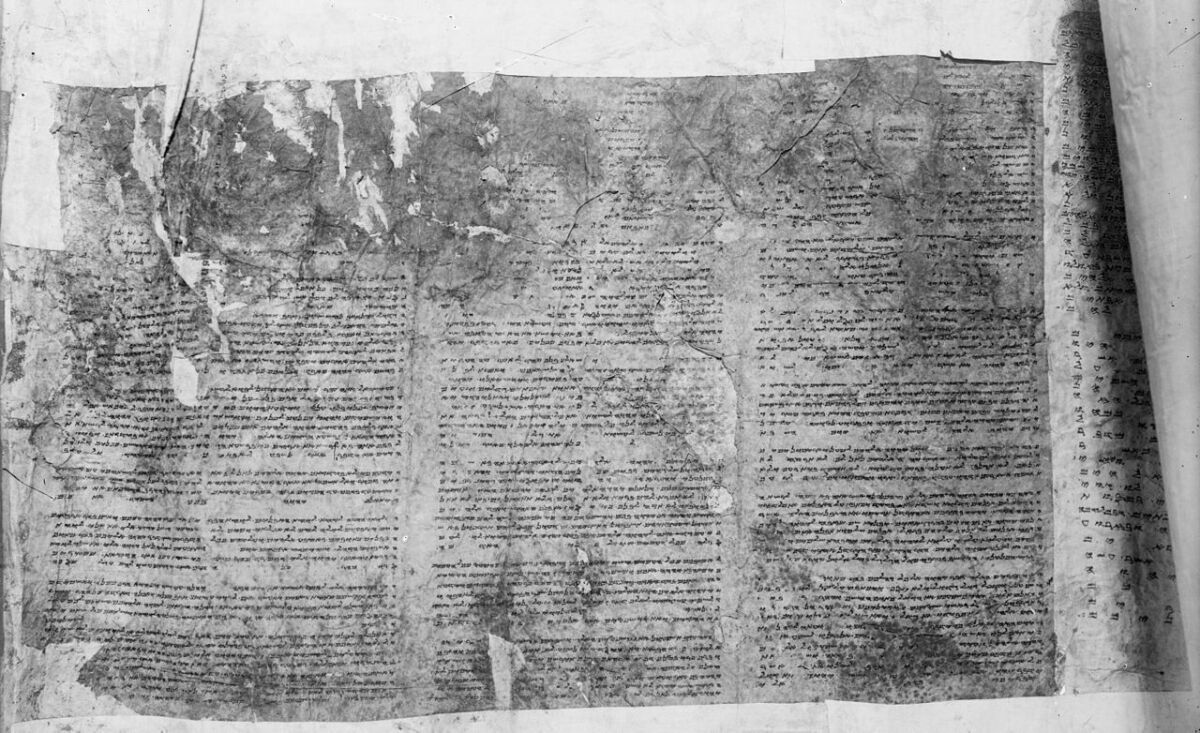
It is on this common allegation of rabbinic “deflation” of the numbers in Genesis 5 and 11, as part of a second century c.e. so-called “dirty little secret about modern [sic] Jewish calendar” (as one lxx proponent puts it), that the peculiar Samaritan Pentateuch chronologies come back into focus. That’s because, again, the Samaritan Pentateuch is widely held to have taken its form by around 100 b.c.e.—centuries prior to this alleged time of “deflation” and well before Jesus was on the scene. And what do we see, at least in the antediluvian numbers of the sp? Low chronologies already matching those of the Masoretic Text.
As far as a Christian recognition of Jesus’s arrival during the sixth millennium, or by the year 6000, it is in no way necessary to adhere to the lxx chronology to make this fit—quite the contrary. Numerous New Testament passages foretell a “second coming” of Jesus to fulfill remaining messianic promises in “power and glory” (e.g. Mark 13:26; Acts 1:11; Revelation 19; 20:4)—and there is even allusion to the significance of a “first coming” to make an expiation for sin around the year 4000. (The above-quoted article at least makes note of this chronological significance seen in Jewish and Christian circles, in both the years 4000 and 6000.)
Again, based on the chronologies of the mt for Genesis 5 and 11, this would put us currently somewhere within the final decades—or years—prior to the year 6000. (It’s one reason why the famous scientist Sir Isaac Newton—who some may be surprised to find out was a devout Christian who wrote far more on theology than science—proposed that our 21st century would see the end of the age of man and the ushering in of the Kingdom of God.)
Why Would the LXX Chronology Have Been Extended?
If the Hebrew mt figures are correct, as argued here, then that begs the question in reverse: What would be the reason for the Greek lxx timeline to have been inflated by well over 1,000 years? There is a fairly popular answer to this allegation, which does provide a good general explanation. However, as lxx proponents highlight, in one key respect it falls short. Actually, the popular response to this question is only part of the answer.

The standard response is to point to the example of the Egyptian priest-historian Manetho, of the same third century b.c.e., and to highlight what can be described as his own nationalistic attempts to dramatically inflate the antiquity of Egypt. That this would explain the lxx’s own inflation, within the same milieu of Greek Ptolemaic Egypt, in attempting to mirror this timeline of Egypt.
This would agree with the early rabbinic view of the Septuagint translation (accorded as a tragedy comparable to that of the biblical golden calf incident)—with talmudic and other writings addressing “changes for King Ptolemy” that were made by the lxx translators (as attested in Bavli Megillah, Soferim, Sefer Torah, etc).
This idea of a third century b.c.e. “extension” of history extends far beyond simply Manetho and Egyptian history. The contemporary third century b.c.e. Babylonian historian Berossus was also locked into this “battle” of sorts, in attempting to assert greatest national antiquity. Jack Finegan describes in his book Light of the Ancient Past: “Manetho was born at Sebennytus (now Samannud) in the Delta. Eventually he rose to be high priest in the temple at Heliopolis. Berossos of Babylon was practically a contemporary, and the two priests became rivals in the proclamation of the antiquity and greatness of their respective lands” (pages 65-66).
About this, Dr. Herman Hoeh wrote in The Compendium of World History (Volume 1, pages 18-19):
In Manetho’s time this spirit of competition reached a climax. Egypt and Babylonia were vying with each other for influence over the Greek-speaking world.
Each sought to be known as the founder of civilization, of cultural and religious institutions, of political unity. Vanity was coupled in both by a deep sense of inferiority, for both were peoples subject to the Greeks. To rise above that feeling, each claimed to be the first people of earth, not alone in the sense of civilization, but in the sense of time.
To justify their claims to antiquity, Manetho and Berossos utilized their early records, the king lists of the various cities, and cleverly marshalled them together in consecutive order. …
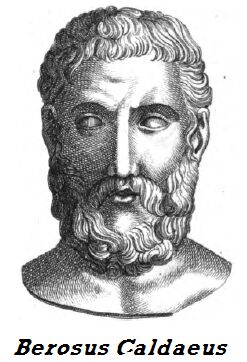
Is it just coincidence, then, that within the very same third-century b.c.e.—and not only that, within the very same nation as Manetho (Ptolemaic Egypt)—we should see the same artificial extension of antiquity of biblical history into the very same language? The changes made to Genesis 5 and 11 would not have to be necessarily overt, however; the overall lifespans from Adam onward could be left generally the same. Only the ages of begettal would need to be changed, each by an even 100 years, thus more or less “cleanly” resulting in an overall addition of nearly 1,500 years of antiquity to the biblical account, and thus resulting in a text that “matched,” in a sense, the antiquity of the world being established in other texts.
The logic for this appears sound—but there’s a catch.
LXX Inflation Equals SP Inflation?
This argument from mt proponents is, of course, generally made on the basis that the Greek translators were themselves adjusting ages for the lxx—separate and apart from what was in the Hebrew text (Vorlage) they were working from. Of course, the argument among lxx proponents is that the translators should not be charged as guilty with arbitrarily changing things in the text based on their own ideas (after all, in general, the lxx Torah is a generally close translational match to the Hebrew, certainly not a creatively imaginative product). Instead, they argue that the longer ages must have already been contained within this original Hebrew Vorlage they were translating from.
lxx proponents likewise point out the Samaritan Pentateuch—an entirely separate textual tradition, in large part near identical to the Hebrew mt—and at least its own Genesis 11, post-Flood chronology largely matching that of the longer lxx. Thus, if the lxx chronologies in Genesis 5 and 11 are to be explained away as the product of arbitrary 100-year inflations at the hand of Greek translators, one must also explain how the sp’s nearly identical “inflation” of Genesis 11 occurred, separate and apart from the Greek?
Again, from “The Case for the Septuagint’s Chronology in Genesis 5 and 11”: “lxx inflation hypotheses cannot account for the higher ba [birth ages] in sp [Genesis] 11 ….
In summary, lxx inflation hypotheses fail (in part or whole) … [because t]hey cannot explain the matching ba in the sp and lxx of Genesis 11, which would need to arise separately and independently, and yet somehow identically, if any lxx inflation hypothesis were true. The sp certainly did not originate from the lxx.
It’s an excellent point. The sp did not originate from the lxx—and logically, neither did its near-identical, long post-Flood Genesis 11 chronology.
Just the opposite.
Reenter the Samaritan Pentateuch
In “Design and Development of the Holy Scriptures,” Dr. Martin wrote: “The Law [Torah] portion of the Septuagint was without question translated from the Samaritan Pentateuch, not the official Jewish version [mt]. They agree in 2,000 places where they disagree with the official Jewish version.” Renowned scholar on the subject, Raphael Weiss, notes specifically 1,900 areas in which the sp and lxx agree, in contrast to the mt.
Dr. Martin therefore attributes the translation of the lxx to the Samaritans, or Samaritan-influenced Jews. Dr. Hoeh concurred: “Between the time of Alexander the Great and the second century b.c.e. the Samaritans tried their best to infiltrate the Jewish community and alter the inspired scriptures. They failed. But they did succeed in foisting on the world a corrupt translation of the Hebrew into Greek. That translation is called the Septuagint, or Seventy [lxx]. It was translated by 70 scholars who used texts from Samaritan Palestine” (“The Bible—Myth or Authority?” 1966).
Prof. Emanuel Tov is one of the foremost experts on this subject of early biblical development. He links the sp and lxx together as one textual branch and the mt as of another separate, earlier “conservative” textual branch. This theory of common origin for these sp and lxx texts, separate and apart from the mt, goes back to 1815—called at the time by W. Gesenius the “Alexandrino-Samaritan edition.”
Professor Tov wrote in his excellent 2016 article “The Development of the Text of the Torah in Two Major Text Blocks”:
The closeness of the sp and the lxx has become more and more evident. … Until one does a word-for-word analysis of each of the Pentateuchal books one does not realize how often the lxx and sp are in agreement and carry a secondary nature ….
The popular text that is presupposed by the common ancestor of the lxx and sp group predated the time of the translation of the lxx, and therefore we find ourselves in the fourth century b.c.e. or earlier.
This subject on its own would require a separate article—particularly the formative intrigue among the Persian-Hellenistic-period Jews and Samaritans and the competitive relationship between their priestly classes. This is something hinted at in part in the marriage of the high priest Eliashib’s grandson Manasseh to Nicaso, daughter of Sanballat, governor of Samaria (see Nehemiah 13:28 and Josephus’s Antiquities of the Jews, 11.7-8). Manasseh became established by his father-in-law Sanballat as high priest of Samaria and eventually built a temple at Mount Gerizim.
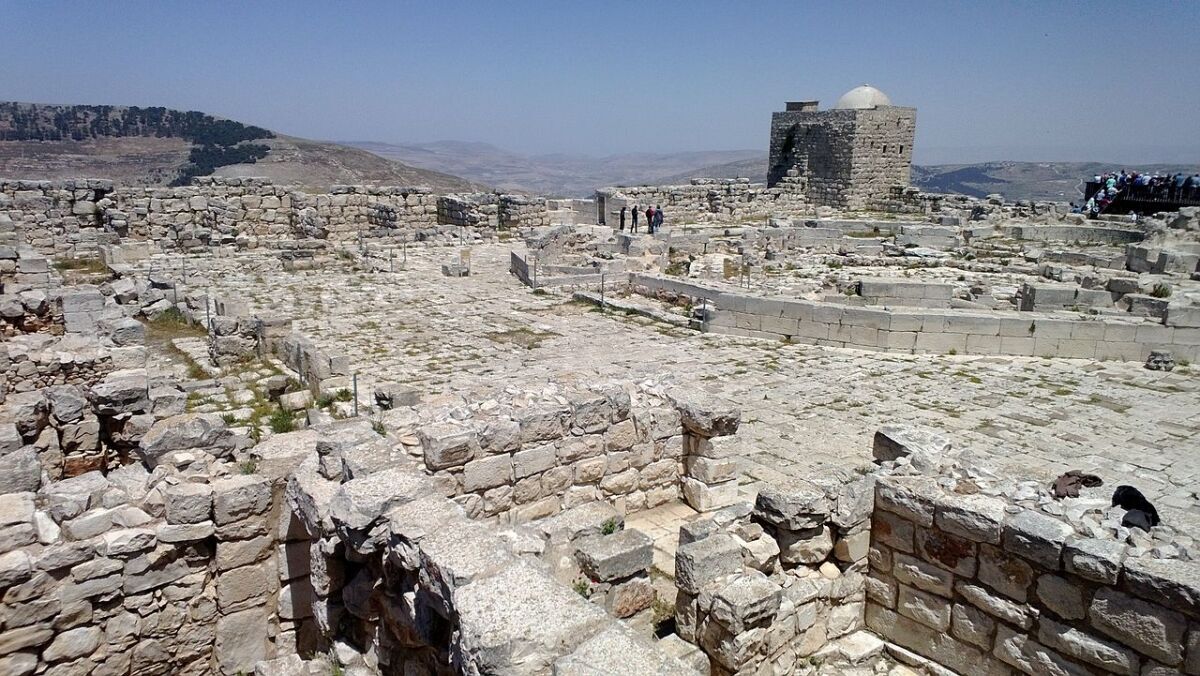
Josephus relates some of the Samaritan intrigue (including even widespread Levitical and priestly defections to the Sanballat/Manasseh-led Samaritan cause):
But there was now a great disturbance among the people of Jerusalem because many of those priests and Levites were entangled in such matches; for they all revolted to Manasseh, and Sanballat afforded them money, and divided among them land for tillage, and habitations also, and all this in order every way to gratify his son-in-law. (Antiquities 11.8.2)
We cannot ignore the period of immense upheaval for the Jewish (and surrounding) populations at this time. This was in the lead up to, and during, the fraught Hellenistic period, a time that saw a widespread collapse in the preserve of religion for many of the Jewish people—to the point of ugly and even murderous struggles for the high priesthood (with one such high priest, Jason, even giving an offering to the Greek god Hercules—2 Maccabees 4:19). Still, as even the New Testament implies (Romans 3:1-4), despite the “faithlessness” of certain diverging communities, with numerous diverging traditions, the impeccable official Hebrew text evidently survived the anarchy, in what became known as the Masoretic Text.
Tov, for his part, suggests that despite the traditional account of the lxx translation of the official Hebrew Scripture during the ensuing third century b.c.e., “it is probably not true that this text [that the lxx was translated from] was chosen by the high priest Eleazar to be sent to Alexandria (thus the Epistle of Aristeas) as a choice copy of the Torah at a time when the careful text of mt already existed” (ibid).
Instead—as asserted by Drs. Hoeh and Martin—another version went to Alexandria, an early form of the Samaritan (which at the time conceivably enjoyed some form of popularity, as hinted at in the above quote from Josephus, about how the priests and Levites “all revolted to Manasseh and Sanballat”). Thus, Gesenius’s description of it as the “Alexandrino-Samaritan edition.”
Tov concluded:
[W]hen trying to understand the textual situation of the Torah in the Second Temple period, we are faced with a veritable textual plurality that is probably reflected in some 10 different textual branches, more than in the other Scripture books. Moving beyond earlier textual theories, I suggest that this plurality should be reduced to a pattern of two tradition blocks, mt and all the other texts. Among these other texts, the (probably Palestinian) block composed of the lxx, the Samaritan Pentateuch, and the pre-Samaritan scrolls, together with their congeners, are the major component. The lxx and sp were based on a common textual tradition characterized by harmonizing readings, especially pluses, among them several inappropriate ones (see Appendix). … Unlike block ii, the mt block remained relatively clean of secondary readings.
The association between the sp and lxx, separate and apart from the mt, is clear. And based on the chronologies of Genesis 5 and 11 alone, an early-variant Samaritan Pentateuch as base text for the Septuagint would make sense. That’s because we have two chronological “extremes”—the entirely shorter mt, and the entirely longer lxx. The sp, on the other hand, with Genesis 5 closer to the mt and Genesis 11 closer to the lxx (yet here still also hearkening to the mt, in omitting Cainan), stands in the middle ground—a logical step in the progression from the mt to the lxx.
And from another, more obvious angle indicating transmission from the Samaritan Pentateuch to the Septuagint: Note that initially, the Septuagint consisted solely of the Torah—the five books of Moses. The later books, and apocryphal additions, were added entirely separately, a century or more later. This may seem initially to be an arbitrary decision, just to translate the first part of the much larger Hebrew Bible. But what was the exclusive “holy” scripture of the Samaritan community? It was, likewise, solely the Torah—the Samaritan Pentateuch—the remaining books having been firmly rejected.

Archaeological Corroboration?
Unfortunately, we cannot yet turn to any specific, archaeologically-discovered scroll to completely settle the debate about the original chronologies of Genesis 5 and 11. But as we have seen, the evidence consistently points to the Masoretic Text as being accurate, consistent and original. And at least from a broader perspective, that is what archaeology has only continued to demonstrate over the last several decades.
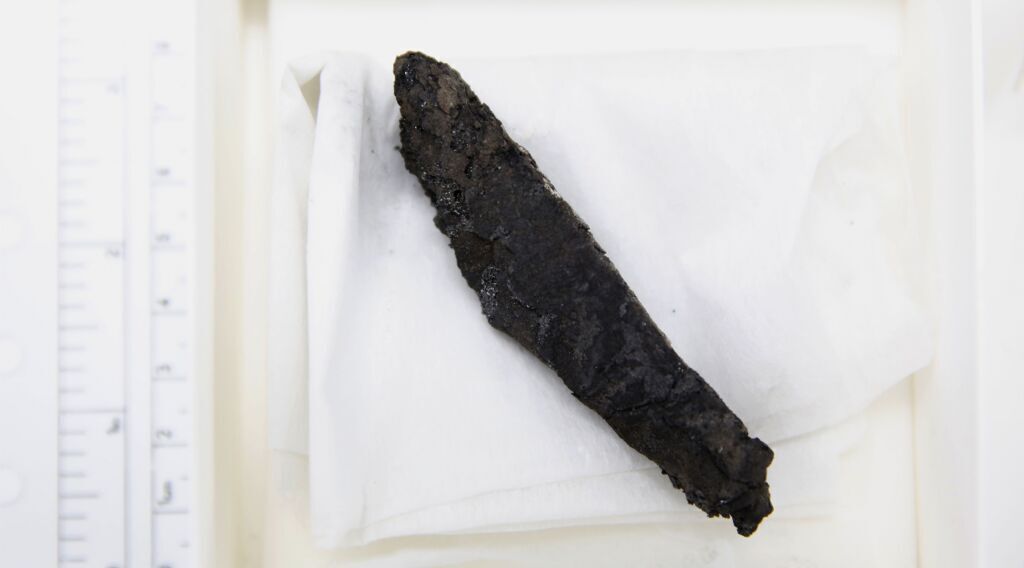
A case in point was the astounding digital “unwrapping” in 2016 of a charred, 2,000-year-old scroll (see here for our article about this discovery). This technological marvel showed the letter-for-letter, absolute precision of the Masoretic Text of Leviticus 1 and 2. In the words of Tov, at the time of press release: “This is quite amazing for us. In 2,000 years, this text has not changed.”
Then there are the seventh-century b.c.e. Ketef Hinnom scrolls, the earliest uncovered biblical text so far, containing verses from Numbers and Deuteronomy. These texts, discovered in a tomb in the 1970s, are letter-for-letter exact to the Masoretic Text (with an arguable difference of a couple of letters). Of course, such a Hebrew text cannot be compared letter-for-letter with the Septuagint Greek, given the latter is a translation. Yet the scrolls can be compared with the Samaritan Pentateuch version. And lo and behold, there is greater letter variation with the sp (an additional yod in Numbers 6:25). Not much, but still more than the mt—enough, at least in this case, to prove the latter as indeed the more authentic and original Torah text (and conversely implicating the lxx, by translational association with the sp. See here for more detail).
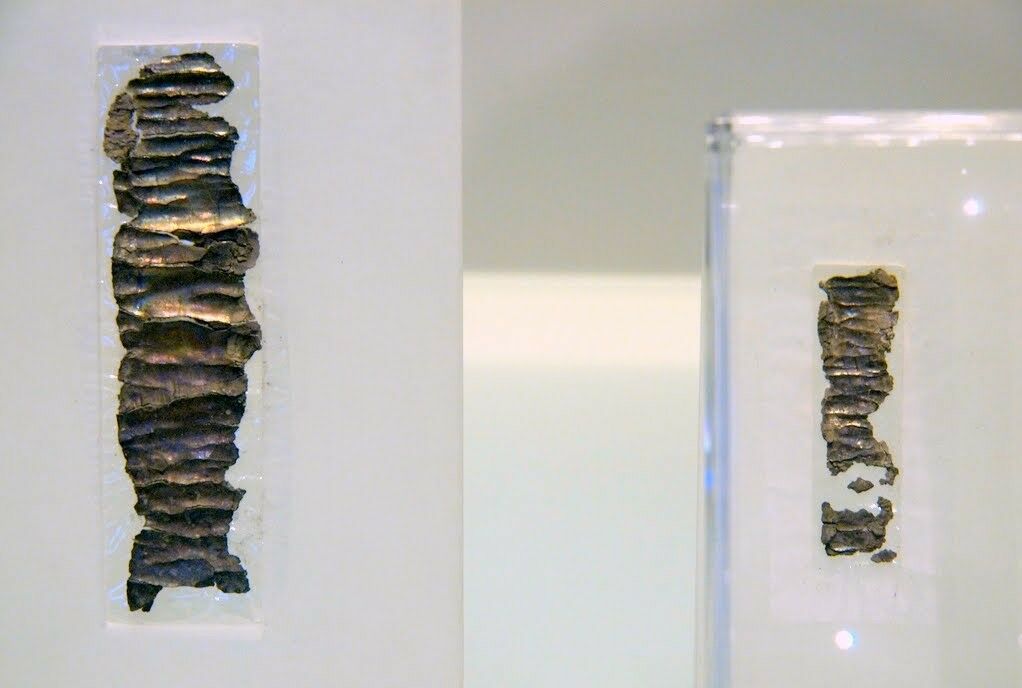
In Sum
What, then, constitutes the most reliable, internal biblical chronology for the period from Adam on through the Flood and all the way to the patriarchs Abraham, Isaac and Joseph? What version preserves the original Hebrew text? It has to be—from virtually every conceivable angle of investigation—the text already placed on a pedestal and utilized by most translations of the Hebrew Bible: the Masoretic Text, with its roughly 2,000 years from Adam to the patriarch Abraham.
We have no reason to doubt the authenticity of the numbers preserved in Genesis 5 and 11 of the Masoretic Text. Quite the contrary—the consistent, pedantic scribal tradition for this text, and the numeric harmony it contains, speaks for itself.